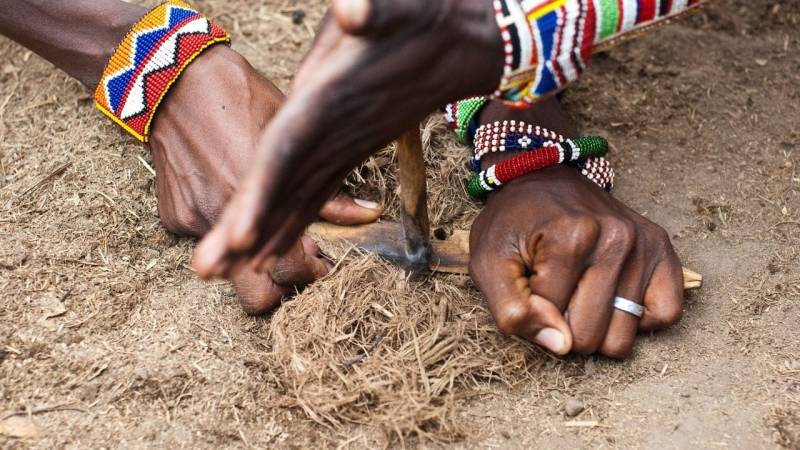
hand drill
Nomen
Meaning
The hand drill is a primitive fire-starting tool used in survival, bushcraft, and wilderness skills. It consists of a wooden spindle and a fireboard. By rotating the spindle rapidly between the palms of your hands, friction is created against the fireboard, generating heat and eventually creating an ember. This ember can then be transferred to a tinder bundle to start a fire. The hand drill is a valuable skill to master in outdoor activities as it allows you to create fire without relying on modern tools or equipment. It is an essential technique for self-reliance and survival in the wilderness.

Examples
„I love using the hand drill to start a fire in the wilderness. It's a traditional method that requires skill and patience.“
„The hand drill is a simple tool consisting of a wooden spindle and a fireboard. By rotating the spindle rapidly between your hands, friction is created, generating heat that ignites the tinder on the fireboard.“
„When I first learned how to use the hand drill, it took me a while to get the technique right. But with practice, I became more proficient and could start a fire in no time.“
„The hand drill is a great survival skill to have, especially in situations where you don't have access to matches or lighters. It's a reliable method that has been used for centuries by indigenous peoples around the world.“
„One of the challenges of using the hand drill is finding the right materials. You need a softwood spindle and a fireboard made of a harder wood. It's important to choose the right combination to ensure a successful fire-starting process.“
Origin
The word "hand drill" originates from the combination of the words "hand" and "drill". The term "hand" refers to the human hand, while "drill" refers to a tool used for making holes or creating friction. The concept of using a hand drill can be traced back to ancient times, where it was used by various cultures around the world.
The hand drill has its roots in primitive technology and is believed to have been one of the earliest tools used by humans. It was used for various purposes, such as starting fires, creating holes in materials, and even for woodworking. The hand drill consists of a spindle, a hearth board, and a bow or handhold.
Over time, the hand drill has evolved and been refined. Different cultures and civilizations have developed their own variations of the hand drill, using different materials and techniques. For example, Native American tribes in North America used a hand drill made from a wooden spindle and a hearth board made from softwood.
In modern times, the hand drill is still used by survivalists, bushcraft enthusiasts, and those interested in primitive skills. It is considered a valuable tool for wilderness survival, as it allows one to create fire without the need for matches or lighters. The hand drill is also used in various traditional crafts and hobbies, such as woodworking and leatherworking.
Synonyms
Fire drill, Friction fire, Bow drill, Fire starter, Fire making, Fire starting, Fire ignition, Fire starting tool
Antonyms
Electric drill, Power drill, Cordless drill, Drill press, Hammer drill, Impact drill, Rotary drill, Pneumatic drill
Relatives
Fire making, Friction fire, Bow drill, Fire starter, Primitive technology, Bushcraft, Survival skills, Natural materials
Historical and cultural importance
The hand drill is a primitive fire-starting tool that has been used by various cultures throughout history. It holds great historical and cultural significance as it represents the ingenuity and resourcefulness of early humans in their quest for survival.
One of the earliest known uses of the hand drill can be traced back to the Stone Age, where it was used by our ancestors to create fire for warmth, cooking, and protection. This simple yet effective tool consists of a wooden spindle and a fireboard. By rapidly rotating the spindle between the palms of the hands, friction is generated, creating heat that ignites a small ember on the fireboard.
Many indigenous cultures around the world still rely on the hand drill as a primary method of fire-making. For example, the Aboriginal people of Australia have been using the hand drill for thousands of years, passing down their knowledge and techniques from generation to generation. In addition to its practical use, the hand drill holds deep cultural significance for these communities, symbolizing their connection to the land and their ancestral traditions.
Today, the hand drill is often used by survivalists, bushcraft enthusiasts, and those seeking to reconnect with nature. It serves as a reminder of our ancient roots and the skills that were once essential for our survival. By mastering the art of the hand drill, we can gain a deeper appreciation for the resourcefulness and resilience of our ancestors.
More information about the term hand drill
What is a Hand Drill?
A hand drill is a primitive tool used for creating fire by friction. It is a simple yet effective method of fire starting that has been used by humans for thousands of years. The hand drill consists of two main components: a spindle and a fireboard.
How does it work?
To use a hand drill, you need to create a small depression in the fireboard and place the spindle in it. The spindle is then rotated rapidly between the palms of your hands, creating friction and heat. This heat causes the wood dust to smolder and eventually ignite, creating an ember. The ember can then be transferred to a tinder bundle and blown into a flame.
Choosing the right materials
When using a hand drill, it is important to choose the right materials. The spindle should be made of a hardwood, such as oak or hickory, while the fireboard should be made of a softer wood, such as cedar or pine. The spindle should be straight and smooth, with a pointed tip. The fireboard should have a small depression in the center to hold the spindle.
Technique and practice
Using a hand drill requires practice and technique. The key is to apply downward pressure on the spindle while rotating it rapidly between your palms. This pressure helps create friction and generate heat. It is important to maintain a steady rhythm and speed to generate enough heat to create an ember. With practice, you will develop the muscle memory and technique needed to successfully create fire with a hand drill.
Advantages and disadvantages
The hand drill has several advantages. It is a lightweight and portable fire starting method that requires minimal equipment. It can be used in various weather conditions and is not dependent on external tools or resources. However, it does require physical strength and stamina to use effectively. It can also be time-consuming and may not be the most efficient method of fire starting in certain situations.
Conclusion
The hand drill is a traditional and reliable method of fire starting that has stood the test of time. It is a skill that every survivalist and outdoor enthusiast should learn. By mastering the technique and choosing the right materials, you can create fire in the wilderness using nothing but your own hands and the power of friction.
Back to overview

